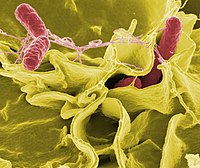
Photo from wikipedia
Food-producing animals are considered a leading source of human Salmonella infections in Korea. However, there is a lack of comprehensive and up-to-date data regarding the diversity and resistance profiles of… Click to show full abstract
Food-producing animals are considered a leading source of human Salmonella infections in Korea. However, there is a lack of comprehensive and up-to-date data regarding the diversity and resistance profiles of Salmonella serotypes in these animals. Therefore, this study aimed to determine the distribution and antimicrobial resistance profiles of Salmonella serotypes isolated from cattle, pigs, and chickens in Korea between 2010 and 2018. A total of 3018 Salmonella isolates were obtained from 16 laboratories/centers participating in the Korean Veterinary Antimicrobial Resistance Monitoring System. Salmonella serotypes were identified from the following isolates: 179 cattle (17 serotypes), 959 pig (45 serotypes), and 1880 chicken (64 serotypes). The most frequent serotypes in cattle (Typhimurium, Salmonella 4,[5],12:i:-, and Schwarzengrund), pigs (Typhimurium, Rissen, and S. 4,[5],12:i:-), and chickens (Enteritidis, Albany, Virchow, and Montevideo) accounted for more than 50% of the total serotypes in the respective animal species. To the best of our knowledge, Salmonella 4,[5],12:i:- has not been identified in cattle in Korea to date. More than 80% of the isolates demonstrated resistance to at least one antimicrobial agent. Multidrug-resistance was found in almost half of the serotypes; the highest proportion in cattle (59.2%), followed by pigs (53.4%), and chickens (45.7%). Significant proportions of the serotypes were resistant to ampicillin, streptomycin, and tetracycline. Ceftiofur and ciprofloxacin resistance rates were the highest in Salmonella isolated from chickens (17.1% and 4.1%, respectively) and cattle (10.1% and 3.9%, respectively) compared to that in pigs. Among the frequent serotypes, Albany demonstrated the highest resistance rate (>90%) to five different antimicrobials. Alarmingly, some Salmonella serotypes that are frequently associated with human infections demonstrated a trend of increasing resistance to critically important antibiotics, including 3rd generation cephalosporins and quinolones. Collectively, the presence of antibiotic-resistant Salmonella in food-producing animals poses a potential risk to public health.
Journal Title: International journal of food microbiology
Year Published: 2020
Link to full text (if available)
Share on Social Media: Sign Up to like & get
recommendations!